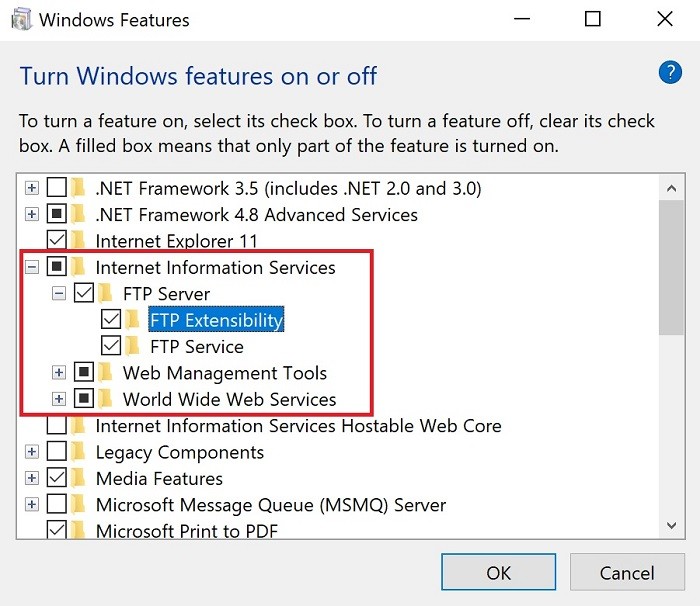


By setting up a chroot jail, you can ensure that users are unable to access other parts of filesystem, which can help prevent unauthorized access or data breaches. This can be useful if you have limited resources or if you want to prioritize other network traffic over FTP traffic.Ĭhroot Jail − A chroot jail is a security mechanism that limits access of a user to a specific directory and its subdirectories. You can also use tools like netstat or tcpdump to monitor FTP traffic in real-time.īandwidth and File Transfer Limitations − If you want to limit amount of bandwidth used by FTP clients or limit size of files that can be transferred, you can configure these limitations in nf. Monitoring and Logging − To keep track of FTP server activity, you can configure vsftpd to log all incoming and outgoing FTP traffic. To enable SSL/TLS encryption, you will need to generate an SSL/TLS certificate and configure vsftpd to use it. SSL/TLS Configuration − If you want to add an extra layer of security to your FTP server, you can enable SSL/TLS encryption. You should open these ports on your firewall to allow FTP traffic to pass through. By default, vsftpd uses port 21 for FTP control connections and ports 1024-65535 for passive data connections. To create virtual users, you will need to use a separate tool such as vsftpd_virtual_users or PAM (Pluggable Authentication Module) modules.įirewall Configuration − To ensure that your FTP server is secure, you should configure your firewall to allow only necessary ports to be open.

However, you can also create virtual users that are not tied to local system users. User Management − By default, vsftpd allows local system users to log in and access files on server. In addition to steps outlined above, there are a few other things you may want to consider when setting up an FTP server in Ubuntu. Once you are connected to FTP server, you should be able to see files and directories on server. If you enabled anonymous access, you can use username "anonymous" and any password. You will be prompted to enter a username and password. Open your FTP client and connect to your Ubuntu machine using IP address or hostname of machine. There are many FTP clients available for Ubuntu, including FileZilla and gFTP. To test FTP server, we need to connect to it using an FTP client. This command will restart vsftpd service. To restart FTP server, open a terminal window and type following command − sudo systemctl restart vsftpd Step 4: Restart FTP ServerĪfter making necessary changes to nf file, we need to restart FTP server to apply changes. Remove "#" symbol from beginning of "local_enable=YES" line to allow local users to log in. Remove "#" symbol from beginning of "anon_upload_enable=YES" line to allow anonymous users to upload files.įinally, find following line in nf file − # Uncomment this to allow local users to log in. Next, find following lines in nf file − # Uncomment this to allow anonymous FTP user to upload files. Remove "#" symbol from beginning of "write_enable=YES" line to enable FTP write access. To enable FTP access, we need to edit nf file and make some changes.įind following lines in nf file − # Uncomment this to enable any form of FTP write command. Step 3: Enable FTP Accessīy default, FTP access is disabled in Ubuntu. This command will open nf file in nano text editor. To edit nf file, open a terminal window and type following command − sudo nano /etc/nf configuration file for vsftpd is located at /etc/nf. To configure FTP server, we need to edit configuration file. Once FTP server package is installed, we need to configure FTP server.
#Ubuntu install ftp server update
This command will update package list and install vsftpd package. Once terminal is open, type following command − sudo apt-get update To install vsftpd, open a terminal window by pressing "Ctrl+Alt+T" keys on your keyboard. In this article, we will be using vsftpd as it is a popular and easy-to-use FTP server package. There are several FTP server packages available for Ubuntu, including vsftpd, proftpd, and pure-ftpd. The first step in setting up an FTP server in Ubuntu is to install FTP server package.
#Ubuntu install ftp server how to
In this article, we will discuss how to install and configure an FTP server in Ubuntu. Ubuntu, a popular Linux distribution, comes with many FTP servers available for installation. An FTP server allows clients to connect to server and access files stored on server. FTP (File Transfer Protocol) is a popular protocol used for transferring files between client and server machines.


 0 kommentar(er)
0 kommentar(er)
